#oem module software
Explore tagged Tumblr posts
Text
Best Automobile Dealership Management System (DMS) Company in India
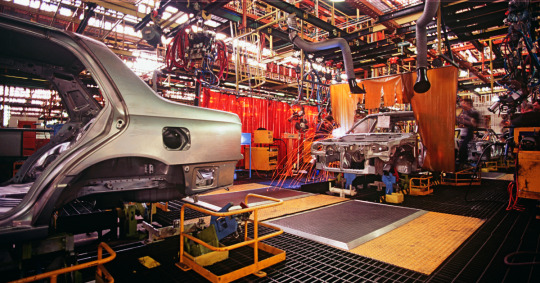
In the rapidly evolving automobile industry, managing dealership operations efficiently is crucial for success. Dealership management systems (DMS) play a vital role in streamlining various processes such as sales, inventory management, customer relationship management (CRM), and service operations. Among the plethora of DMS providers in India, Autobooom stands out as the best automobile DMS company, offering innovative solutions tailored to meet the unique needs of dealerships across the country.
The Rise of Autobooom
Founded with the vision of transforming the automobile dealership landscape, Autobooom has quickly established itself as a leader in the Indian market. The company’s success can be attributed to its commitment to innovation, customer-centric approach, and comprehensive suite of services that address every aspect of dealership management.
Key Features of Autobooom’s DMS
Autobooom’s DMS is designed to enhance efficiency, improve customer satisfaction, and boost profitability for automobile dealerships. Here are some of the standout features:
1. Comprehensive Sales Management
Autobooom’s DMS provides end-to-end sales management solutions. From lead generation and tracking to finalizing sales, the system ensures a seamless process. The integrated CRM module helps in maintaining detailed customer profiles, managing follow-ups, and enhancing the overall customer experience.
2. Robust inventory management
Managing inventory effectively is critical for any dealership. Autobooom’s DMS offers real-time inventory tracking, automated stock replenishment, and detailed reporting. This helps dealerships maintain optimal stock levels, reduce carrying costs, and avoid stockouts or overstocking.
3. Advanced Customer Relationship Management (CRM)
Autobooom’s CRM module is designed to build and maintain strong customer relationships. It includes features like automated follow-ups, personalized communication, and customer feedback management. This not only improves customer retention but also helps acquire new customers through referrals.
4. Efficient Service Management
The service management module in Autobooom’s DMS streamlines service operations, from booking appointments to managing repairs and maintenance. The system provides detailed service histories, tracks service orders, and automates reminders for scheduled maintenance, enhancing customer satisfaction and service revenue.
5. Detailed Analytics and Reporting
In today’s data-driven world, having access to detailed analytics is crucial. Autobooom’s DMS offers comprehensive reporting tools that provide insights into sales performance, inventory status, service efficiency, and customer satisfaction. These analytics help dealerships make informed decisions and drive business growth.
6. User-Friendly Interface
One of the standout features of Autobooom’s DMS is its user-friendly interface. The intuitive design ensures that users can navigate the system easily, reducing the learning curve and increasing productivity.
Why choose Autobooom?
Several factors set Autobooom apart from other DMS providers in India:
1. Tailored Solutions
Autobooom understands that every dealership is unique, with its own set of challenges and requirements. The company offers tailored solutions that can be customized to meet the specific needs of each dealership, ensuring maximum efficiency and effectiveness.
2. Strong customer support
Exceptional customer support is a cornerstone of Autobooom’s service. The company provides 24/7 support to address any issues or concerns promptly, ensuring minimal downtime and disruption to dealership operations.
3. Continuous Innovation
Autobooom is committed to staying ahead of the curve by continuously innovating and updating its DMS. The company regularly incorporates feedback from customers and industry trends to enhance its system, ensuring that dealerships always have access to the latest and most effective tools.
4. Competitive Pricing
Despite offering a comprehensive suite of features, Autobooom’s DMS is competitively priced. The company offers flexible pricing plans to accommodate the budgets of different dealerships, making advanced dealership management solutions accessible to all.
Case Studies: Success Stories with Autobooom
Case Study 1: Transforming Sales Operations
A prominent dealership in Mumbai was struggling with managing its sales operations. The manual processes were time-consuming and prone to errors, leading to customer dissatisfaction and lost sales opportunities. After implementing Autobooom’s DMS, the dealership saw a significant improvement in sales efficiency. The automated lead management system ensured timely follow-ups, while the CRM module helped build stronger customer relationships. As a result, the dealership experienced a 25% increase in sales within six months.
Case Study 2: Enhancing Inventory Management
A mid-sized dealership in Bangalore faced challenges with inventory management. Overstocking of certain models and stockouts of popular ones were common issues. Autobooom’s DMS provided real-time inventory tracking and automated stock replenishment, helping the dealership maintain optimal stock levels. The detailed reporting tools provided insights into sales trends, allowing for better inventory planning. This resulted in a 30% reduction in carrying costs and improved customer satisfaction.
Case Study 3: Streamlining Service Operations
A dealership in Delhi was struggling with managing its service operations efficiently. Delayed service appointments and a lack of proper service histories were major pain points. Autobooom’s DMS streamlined the entire service process, from booking appointments to tracking repairs. The system’s service reminders ensured timely maintenance, leading to happier customers and increased service revenue. The dealership reported a 40% improvement in service efficiency and a significant increase in repeat business.
The Future of Dealership Management with Autobooom
As the automobile industry continues to evolve, the role of DMS providers like Autobooom will become even more critical. With advancements in technology such as artificial intelligence (AI) and the Internet of Things (IoT), the future of dealership management looks promising. Autobooom is already exploring these technologies to enhance its DMS further.
1. AI-Driven Insights
AI can provide deeper insights into customer behavior, sales trends, and inventory management. Autobooom is working on integrating AI-driven analytics into its DMS, which will help dealerships make more informed decisions and predict future trends accurately.
2. IoT-enabled service management
IoT has the potential to revolutionize service management. With IoT-enabled vehicles, dealerships can receive real-time data on vehicle health and performance. Autobooom is exploring ways to integrate IoT into its DMS, allowing for proactive maintenance and improved service efficiency.
3. Enhanced Mobility Solutions
With the increasing use of mobile devices, Autobooom is focusing on enhancing its mobile solutions. This includes developing mobile apps for sales, service, and inventory management, allowing dealership staff to access critical information and perform tasks on the go.
Conclusion
In the competitive landscape of the Indian automobile industry, having a robust and efficient DMS is essential for success. Autobooom has proven to be the best automobile DMS company in India, offering comprehensive, innovative, and customizable solutions that address the unique needs of dealerships. With a strong focus on customer support, continuous innovation, and competitive pricing, Autobooom is set to lead the way in transforming dealership management in India.
Dealerships looking to enhance their operations, improve customer satisfaction, and boost profitability should consider partnering with Autobooom. With its advanced features and commitment to excellence, Autobooom is the ideal choice for dealerships aiming to stay ahead in the fast-paced automobile industry.
#Automobile dms#automobile dms company in india#dms dealership company in india#AutoBooom dms Features#automobile Modules For OEM#DMS Features for Multi-Brand Workshops#oem module for dms#best dms dealership company in india#automobile dms company#Module Features For Dealers#Module For OEMs#oem module software#dms software for multibrand#Car dms#dms company in india#Multi Brand Workshops#DMS for Automobile#oem dealer management system#ERP Software for inventry#Dealer Management System module for dealers
0 notes
Text
IETM for Beginners A Quick Guide to IETM Code and Pixels
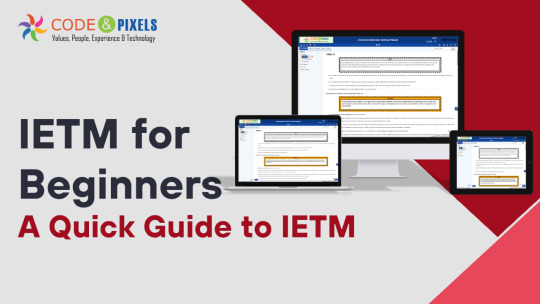
IETM: Interactive Electronic Technical Manual
Training Aids to Defence Client
If you are a supplier of defence then along with the system/equipment you also need to provide Training Aids
(CBT) — Computer-Based Training
Charts and Bloups
Video Film
Training Work Modules
Manuals Hard Copies
IETM
Evolution of Documentation in Defence
Before — Hardcopies and PDFs in DVDs (Upto 2015)
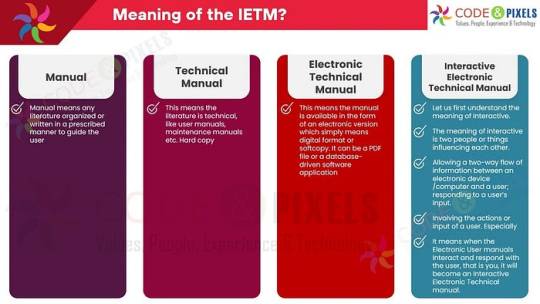
What is the meaning of the IETM?
Manual: Manual means any literature organized or written in a prescribed manner to guide the user.
TechnicalManual: This means the literature is technical, like user manuals, maintenance manuals etc. Hard copy
Electronic Technical Manual: This means the manual is available in the form of an electronic version which simply means digital format or softcopy. It can be a PDF file or a database-driven software application.
Interactive Electronic Technical Manual:
Let us first understand the meaning of Interactive. The meaning of interactive is two people or things influencing each other.
Allowing a two-way flow of information between an electronic device /computer and a user; responding to a user’s input.
Involving the actions or input of a user. Especially
It means when the Electronic User manuals Interact and respond with the user, that is you, it will become an Interactive Electronic Technical manual.
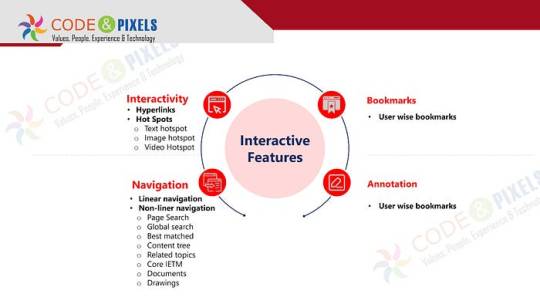
Interactive Features
Interactivity
Hyperlinks
Hot Spots
Text hotspot
Image hotspot
VideHotspot
Bookmarks
User wise bookmarks
Navigation
Linear navigation
Non-liner navigation
Page Search
Global search
Best matched
Content tree
Related topics
Core IETM
Documents
Drawings
Annotation
User wise bookmarks
The documents and pages are many hence, for easy and fast accessibility complete content is converted and stored as a database.
Whenever the user wants some information, IETM software produces the information in a fraction of a second.
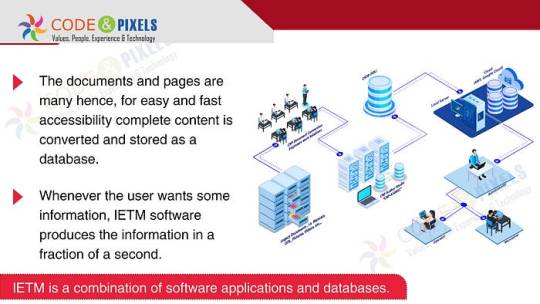
Use or Purpose of the IETM?
The purpose of the Manual is to give information related to the equipment to the end user for quick reference.
All the technicality is written in detail so that when an issue arises, the user can refer to the manual, as every time OEM or technical person or subject matter expert might not be available on the spot to resolve the issue.
If the manual has 10 pages users can refer easily.
But any system used by the defence will have multiple manuals and thousands of page counts and many times a user has to cross-refer between manuals, intra-manual and inter-manual to resolve the issue.
Referring to 10- 15 hard-copy or even soft-copy books simultaneously will be difficult and time-consuming.
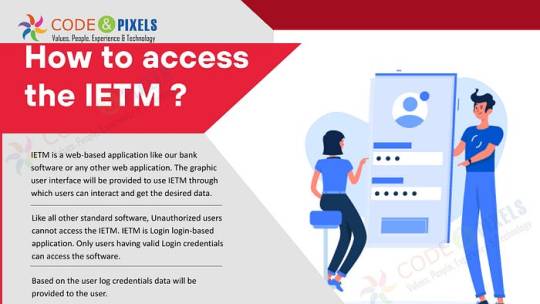
How to access the IETM ?
IETM is a web-based application like our bank software or any other web application. The graphic user interface will be provided to use IETM through which users can interact and get the desired data.
Like all other standard software, Unauthorized users cannot access the IETM. IETM is a Login - login-based application. Only users having valid Login credentials can access the software.
Based on the user log credentials data will be provided to the user.
IETM has 2 types of Users and one Administrator
Maintainer
Operator
If the operator logs in, the user gets all the content related to operator use, similarly if the maintainer logs in only maintenance-related content is visible for that user.
Ideally, all the content is available for both users, because the purpose of the IETM is to refer to the manual to fix the issue.
Administrators can create users who can see the user’s navigation and log-in history and interact with the users using user dashboards through Annotations.
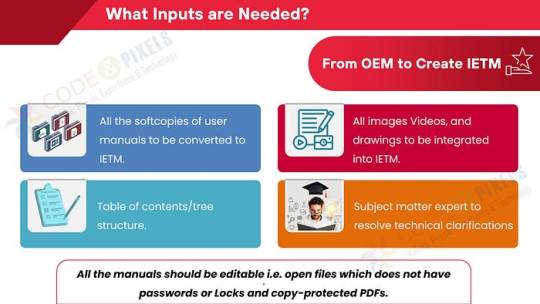
What Inputs are Needed? (From OEM to Create IETM)
All the softcopies of user manuals to be converted to IETM.
All images Videos, and drawings to be integrated into IETM.
Subject matter expert to resolve technical clarifications
Table of contents/tree structure.
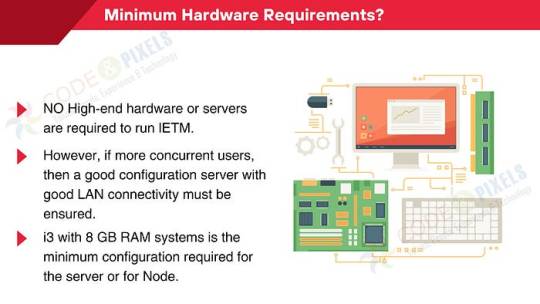
Minimum Hardware Requirements?
NO High-end hardware or servers are required to run IETM.
However, if more concurrent users, then a good configuration server with good LAN connectivity must be ensured.
i3 with 8 GB RAM systems is the minimum configuration required for the server or for Node.
Deliverables
BASED DB (Manuals are covered in the Database)
IETM VIEWER Software
User Manual and Installation Manual
Standards — compliance
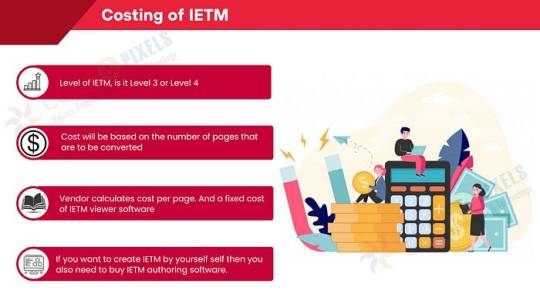
Costing of IETM: (Interactive Electronic Technical Manual)
Level of IETM, is it Level 3 or Level 4
Cost will be based on the number of pages that are to be converted
The vendor calculates the cost per page. And a fixed cost of IETM viewer software
If you want to create IETM by yourself self then you also need to buy IETM authoring software.
What are these Levels?
Level — 1 is any PDF file
Level — 2 is a PDF file with hyperlinks from the table of contents to the body etc.
Level — 3 is an HTML application. More hyperlinks, simple search, a content tree having log a screen with a hardcoded username and password and supplied in the format of EXE so that Windows can easily open
Level — 4 is Software plus Content/manuals converted as Database

Regarding Level — 5, rest assured, till 2028 it will be Level — 4 only. As of now, there is nothing practically called Level — 5. Few are calling virtual reality and Augmented reality and Artificial intelligence Level — 5.
Pulling data from many user inputs and analyzing and giving results are done in Level — 5. IETM software cannot pull the data from various real-time points as No OEM will give the real-time information to third-party software directly. Yes, if the information is available offline, then that information can be imported into IETM and can be used as a reference.

#ietm#software#technology#ietm developement#ietm code and pixels ietm hyderabad#ietm software#elearning#code and pixels#ietm level iv#codeandpixels#ietm level 4 software requirements#technical documentation#ietm document#ietm documentation#interactive electronic technical manual#Ietm Service Providers#Ietm Software Designers of India#Software Development Company#Elearning Solutions Company#E Learning Content Development Company#Online Education#Digital Education#Digital Content#Software Development Solutions#Elearning#Ietm Developers#Econtent Development#Elearning Solutions Providers#Econtent Developers#Econtent
2 notes
·
View notes
Text
Interactive Electronic Technical Manual (IETM) JSG 0852 & S1000D
Code and Pixels Introduction
Code and Pixels Interactive Technologies Private Limited (CNP) is an IETM service provider based in Hyderabad (India).
IETM Services
We have extensive experience in execution of IETMs (INDIAN STANDARD IETM JSG 0852:2001, LEVELS 3,4,5 and European Aviation Standard IETM S1000D, lEVEL4)
Code and Pixels Clients
Partnering with the best to deliver exceptional Quality & Value. We are proud to work with Indian Defence (Army, Navy, and IAF).
Welcome to Code and Pixels
Code and Pixels is the best among the top software development companies in Hyderabad, India. Code and Pixels Interactive Technologies Private Limited (CNP) is an IT service provider based in Hyderabad (India). We provide end-to-end IETM solutions, specialized in the innovative use of technology.
We confidently manage large and complex projects without slipping on delivery deadlines while maintaining the highest standards of quality and efficiency.
Technical Documentation Services
Code and Pixels is the only Company, delivered 50 plus IETMs (Class 3, Class 4, and 5) to Indian defense and many corporates i.e. Tata, L&T, Nova, and Defense labs such as DRDL, RCI, ASL, BDL, ECIL, BEL, and many OEMs.
We assure you that we will deliver IETM as per the end-users expectations adhering to all the standards. We have worked in association with the Naval Technical Group of Navy and also with eMMS team of the Indian Air force and MAG (DRDL) of the Indian Army.
Our experience in delivering 50 Plus projects of IETM will definitely give an edge to your product. We have come across all the hurdles in Project Implementing. IETM looks simple but it has so many challenges while implementing and getting approvals from the client.
Having vast experience, we assure you that we will be your trusted technology partners in delivering IETMs.
Registered with
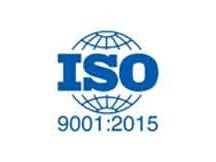

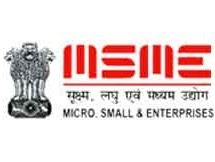
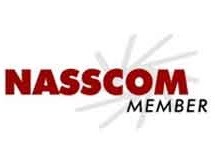
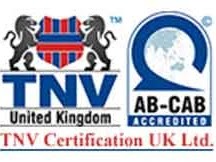
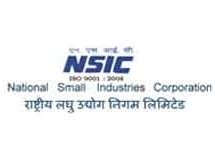
Almost for all the Defense labs and production agencies, we have designed, developed, and installed Interactive Electronic Technical Manual, or Electronic Technical Manual OR Technical Publications (IETP). All these terms refer to IETM Documentations.
We are proud to deliver ARMY IETMs, NAVY IETMs, and Air force IETMs in various cities of INDIA.
We have executed the IETM and CBT projects of OEMs having production centers pan INDIA, in Hyderabad(DRDO, ASL, RCI, BDL, ECIL, BEL) Vishakapatnam, Vizag(HSL), Chennai, Coimbatore, Tamilnadu (ADU, APTARA), Maharashtra, Mumbai(L&T, TATA), Pune(L&T, TATA, Kirloskar), Delhi (SBI, GNU, GIZ, NTPC), Cochin (TIL), Goa(Marine electrical), Kolkata(TIL, Kolkatta University), Bhopal, Utter Pradesh, Lucknow, Noida(SBI, UGC), Gujarat, Surat (PIRAMAL, ANSA DECO), Gandhi Nagar (BOB, INFLIBNET), Kerala, Trivandrum, Bangalore(BEL, Canara Bank, TALLY), Pondicherry(Integra), Gopalpur Cantonment, Odisha (Army AD College).
Proud to be associated with OEMs supplying defense equipment for ARMY, NAVY, and AIR FORCE.
We have developed IETM Framework using open source software hence, no proprietary or licensed software is required to play IETM Viewer, either in Windows Operating systems or in Linux Operating system. The installation process is also very simple and these electronic manuals can be viewed using all the major browsers and all the standard devices i.e. mobiles, tabs, and different size monitors, etc.
Download IETM presentation having information such as “IETM Architecture”, “How to create”, “IETM format”, “S1000D standard”, “Information code list” and about “data module DM” and naming, etc from “download presentations” section of this web site. We have expertise in developing IETM in Indian Defense standard JSG 0852 or European aviation standard S1000D.
We are not JUST a Vendor or Service Provider or S1000D Developers or IETM software developers but we are your trusted partner in the execution of the projects.
Ask for a Live Demo and walkthrough of the IETM software and get the Best quotation to execute the project – [email protected] or call 09849527706
We need information i.e.
how many pages are to be converted (It means what is the volume or page count of all the manuals which you have prepared).
What is the standard asked for? Indian Standard or S1000D?
About Company
Code and Pixels Interactive Technologies Private Limited (CNP) is an IT service provider based in Hyderabad (India).
Get in touch
09849527706
#IETM#S1000D#Code and Pixels#IETM Hyderabad#Interactive Electronic Technical Manual#What is Ietm Level 4#What is Ietm#Ietm Software#Ietm Developement
3 notes
·
View notes
Text
eSync operation in Automotive Applications
At its core, eSync operates as a robust over-the-air (OTA) update and data synchronization platform, enabling seamless communication between vehicles, backend servers, and external devices. Here's a glimpse into how eSync functions within the automotive ecosystem:
OTA Updates: eSync facilitates secure and efficient OTA updates for in-vehicle software, including infotainment systems, telematics modules, electronic control units (ECUs), and other embedded systems. These updates can encompass bug fixes, feature enhancements, security patches, and even firmware updates for various vehicle components.
Data Synchronization: eSync ensures synchronization of data across different vehicle systems and components, enabling real-time exchange of information between onboard sensors, controllers, and cloud-based servers. This synchronization is crucial for applications such as predictive maintenance, remote diagnostics, and fleet management.
Diagnostics and Health Monitoring: By providing remote access to vehicle diagnostics and health data, eSync enables proactive maintenance and troubleshooting, minimizing vehicle downtime and enhancing operational efficiency. Automotive manufacturers and service providers can remotely monitor vehicle health parameters, identify potential issues, and take preventive measures before they escalate.
Significance of eSync in the Automotive Industry
The adoption of eSync brings several transformative benefits to the automotive industry:
Enhanced Safety and Reliability: eSync facilitates timely deployment of software updates and security patches, ensuring that vehicles remain up-to-date with the latest features and safety enhancements. This helps mitigate potential cybersecurity threats and ensures optimal performance and reliability of vehicle systems.
Improved User Experience: With eSync-enabled OTA updates, automotive manufacturers can deliver new features, performance improvements, and personalized experiences to vehicle owners without the need for manual intervention or dealership visits. This enhances user satisfaction and brand loyalty while keeping vehicles technologically relevant throughout their lifecycle.
Cost Savings and Operational Efficiency: By streamlining software updates and diagnostics processes, eSync helps automotive OEMs and fleet operators reduce maintenance costs, minimize recalls, and optimize vehicle uptime. Additionally, remote diagnostics capabilities enable proactive maintenance, reducing the likelihood of costly breakdowns and service disruptions.
Scalability and Future-Proofing: eSync's standardized platform architecture ensures compatibility with a wide range of automotive systems and protocols, enabling seamless integration across diverse vehicle platforms and ecosystems. This scalability and interoperability future-proof automotive systems, allowing for easy adaptation to emerging technologies and industry standards.
Conclusion
As the automotive industry continues its digital transformation journey, connectivity and software innovation are poised to play a pivotal role in shaping the vehicles of tomorrow. eSync emerges as a key enabler, providing a standardized platform for OTA updates, data synchronization, and remote diagnostics across the automotive ecosystem. By enhancing safety, reliability, user experience, and operational efficiency, eSync paves the way for a smarter, more connected, and sustainable automotive future.
0 notes
Text
Embedded Connectivity Solutions Market Size, Share, Demand, Future Growth, Challenges and Competitive Analysis
"Global Embedded Connectivity Solutions Market – Industry Trends and Forecast to 2028
Global Embedded Connectivity Solutions Market, By Technology (2G, 3G, 4G/LTE), Type (Hardware, Software, Others), Services (Over-The-Air Updates, Infotainment, Driver Assistance, Live Traffic Information, e-Call, Vehicle Self-Diagnosis, Intelligent Parking, Safety, Entertainment, Well-Being, Vehicle Management, Mobility Management), End-Users (OEM, Aftermarket), Country (U.S., Canada, Mexico, Brazil, Argentina, Rest of South America, Germany, Italy, U.K., France, Spain, Netherlands, Belgium, Switzerland, Turkey, Russia, Rest of Europe, Japan, China, India, South Korea, Australia, Singapore, Malaysia, Thailand, Indonesia, Philippines, Rest of Asia-Pacific, Saudi Arabia, U.A.E, South Africa, Egypt, Israel, Rest of Middle East and Africa) Industry Trends and Forecast to 2028
Access Full 350 Pages PDF Report @
**Segments**
- **By Component**: The embedded connectivity solutions market can be segmented based on components into hardware and software. Hardware components include microcontrollers, sensors, wireless modules, and other electronic components essential for establishing connectivity. On the other hand, software elements encompass firmware, protocols, and middleware that facilitate communication between different devices and systems.
- **By Connectivity Technology**: This market can also be segmented by connectivity technology, including Wi-Fi, Bluetooth, Zigbee, NFC, cellular networks (4G, 5G), Ethernet, and others. Each connectivity technology serves specific purposes and suits different applications within the embedded connectivity solutions landscape.
- **By Application**: Embedded connectivity solutions find applications across various industries such as automotive, healthcare, consumer electronics, industrial automation, smart cities, and others. These applications leverage connectivity solutions to enable communication, data transfer, and smart functionalities, enhancing overall operational efficiency and user experience.
**Market Players**
- **Texas Instruments Incorporated**: Texas Instruments offers a broad range of embedded connectivity solutions, including microcontrollers, wireless connectivity modules, and software to enable seamless integration in diverse applications.
- **NXP Semiconductors**: NXP Semiconductors is a key player in the embedded connectivity solutions market, providing secure connectivity solutions for automotive, industrial, and IoT applications.
- **STMicroelectronics**: STMicroelectronics offers a comprehensive portfolio of embedded connectivity solutions, including microcontrollers, sensors, and wireless connectivity solutions to address the evolving needs of the market.
- **Microchip Technology Inc.**: Microchip Technology specializes in providing embedded connectivity solutions such as Wi-Fi modules, Bluetooth modules, and microcontrollers for a wide range of applications.
- **Cypress Semiconductor Corporation**: Cypress Semiconductor is known for its reliable embedded connectivity solutions, offering a mix of hardware and software components tailored for IoT, automotive, and consumer electronics applications.
The embedded connectivity solutions market is witnessing significant growth driven by the increasing adoption of IoT devices, smart technologies, and connected systems across various industries. As demandThe embedded connectivity solutions market is experiencing substantial growth attributed to the proliferation of Internet of Things (IoT) devices and smart technologies across diverse industries. One of the key drivers of this market expansion is the rising demand for seamless connectivity solutions that enable devices to communicate and exchange data efficiently. Industries such as automotive, healthcare, consumer electronics, industrial automation, and smart cities are increasingly adopting embedded connectivity solutions to enhance operational efficiency, improve user experience, and enable innovative functionalities.
In terms of components, the market segmentation into hardware and software plays a crucial role in understanding the dynamics of embedded connectivity solutions. Hardware components, including microcontrollers, sensors, and wireless modules, form the backbone of connectivity infrastructure, enabling devices to establish networks and communicate with each other. On the other hand, software components such as firmware, protocols, and middleware are essential for enabling seamless communication and data transfer between diverse devices and systems. The synergistic interplay between hardware and software components is vital for the successful implementation of embedded connectivity solutions across different applications and industries.
Further segmentation based on connectivity technology provides insights into the diverse range of options available for establishing connections between devices. Wi-Fi, Bluetooth, Zigbee, NFC, cellular networks (4G, 5G), and Ethernet are some of the key connectivity technologies driving the embedded connectivity solutions market. Each technology has its unique features, advantages, and limitations, making them suitable for specific applications within the embedded connectivity landscape. For instance, Wi-Fi and Bluetooth are commonly used for short-range wireless communication in consumer electronics, while cellular networks like 5G are preferred for high-speed, long-distance connectivity in industrial and smart city applications.
Market players such as Texas Instruments Incorporated, NXP Semiconductors, STMicroelectronics, Microchip Technology Inc., and Cypress Semiconductor Corporation are leading the charge in offering innovative embedded connectivity solutions tailored to meet the evolving needs of industries embracing IoT and smart technologies. These companies provide a diverse portfolio of products, including microcontrollers, wireless modules, sensors, and software solutions**Global Embedded Connectivity Solutions Market Analysis**:
- **Technology**: The market for embedded connectivity solutions is witnessing rapid advancements in technology, with a focus on 2G, 3G, and 4G/LTE networks. These technologies are essential for establishing robust and reliable connections between devices, enabling seamless communication and data transfer across various industries.
- **Type**: The market segmentation based on type categorizes embedded connectivity solutions into hardware, software, and other components. Hardware components such as microcontrollers and wireless modules form the physical infrastructure of connectivity, whereas software elements like firmware and protocols play a crucial role in facilitating communication and data exchange between devices.
- **Services**: The services offered in the embedded connectivity solutions market include Over-The-Air updates, infotainment, driver assistance, live traffic information, e-Call, vehicle self-diagnosis, intelligent parking, safety, entertainment, well-being, vehicle management, and mobility management. These services enhance the overall functionality, performance, and user experience of connected devices and systems.
- **End-Users**: The end-users of embedded connectivity solutions include Original Equipment Manufacturers (OEM) and aftermarket providers. OEMs integrate embedded connectivity solutions into their products during the manufacturing process, while aftermarket providers offer connectivity solutions as add-on services or upgrades for existing devices and systems.
- **Country**: The market for embedded connectivity solutions is geographically segmented into regions such as the U.S., Canada, Mexico, Brazil, Argentina, Germany, Italy, U.K., France,
Key points covered in the report: -
The pivotal aspect considered in the global Embedded Connectivity Solutions Market report consists of the major competitors functioning in the global market.
The report includes profiles of companies with prominent positions in the global market.
The sales, corporate strategies and technical capabilities of key manufacturers are also mentioned in the report.
The driving factors for the growth of the global Embedded Connectivity Solutions Market are thoroughly explained along with in-depth descriptions of the industry end users.
The report also elucidates important application segments of the global market to readers/users.
This report performs a SWOT analysis of the market. In the final section, the report recalls the sentiments and perspectives of industry-prepared and trained experts.
The experts also evaluate the export/import policies that might propel the growth of the Global Embedded Connectivity Solutions Market.
The Global Embedded Connectivity Solutions Market report provides valuable information for policymakers, investors, stakeholders, service providers, producers, suppliers, and organizations operating in the industry and looking to purchase this research document.
What to Expect from the Report, a 7-Pointer Guide
The Embedded Connectivity Solutions Market report dives into the holistic Strategy and Innovation for this market ecosystem
The Embedded Connectivity Solutions Market report keenly isolates and upholds notable prominent market drivers and barriers
The Embedded Connectivity Solutions Market report sets clarity in identifying technological standardization as well as the regulatory
framework, besides significantly assessing various implementation models besides evaluation of numerous use cases
The Embedded Connectivity Solutions Market report is also a rich repository of crucial information across the industry, highlighting details on novel investments as well as stakeholders and relevant contributors and market participants.
A through market analytical survey and forecast references through the forecast tenure, encapsulating details on historical developments, concurrent events as well as future growth probability
Browse Trending Reports:
Meat Poultry And Seafood Processing Equipment Market Hemiballismus Treatment Market Fluid And Lubricant Market Virtual Infrastructure Manager Market Water Flosser Market Water Saving Shower Heads Market Galactoligosaccharides Market Rocky Mountain Spotted Fever Treatment Market Overhead Conveyor Market Olliers Disease Market Functional Bowel Disorder Agents Market Bio Based Leather Market Melanoma Cancer Diagnostics Market Intracranial Hematoma Drug Market Glucosinolates Market Autorefractor Keratometer Device Market Feed Mycotoxin Modifiers Market
About Data Bridge Market Research:
Data Bridge set forth itself as an unconventional and neoteric Market research and consulting firm with unparalleled level of resilience and integrated approaches. We are determined to unearth the best market opportunities and foster efficient information for your business to thrive in the market. Data Bridge endeavors to provide appropriate solutions to the complex business challenges and initiates an effortless decision-making process.
Contact Us:
Data Bridge Market Research
US: +1 614 591 3140
UK: +44 845 154 9652
APAC : +653 1251 975
Email: [email protected]"

0 notes
Text
Red Hat-certified Micron CZ122, CZ120 Memory Expansions

Presenting the Micron CZ122 and the memory expansion portfolio certified by Red Hat
Micron CZ122
Micron is announcing the release of certification samples for the Micron CZ122, its newest memory expansion module based on Compute Express Link (CXL) 2.0. Along with this noteworthy achievement, Micron is also announcing that the Red Hat Enterprise Linux version 9.3 operating system has certified the CZ122 and its predecessor, the CZ120. These achievements highlight Micron’s dominance in providing enterprise data centers and hyperscalers with high-quality, high-performance solutions.
With a maximum memory capacity of 256GB and a memory bandwidth of 37GB/s, the Micron CZ122 module delivers notable improvements in hardware-based heterogeneous interleaving, security features, and reliability, availability, and serviceability (RAS). The CZ122 and CZ120 are certified with Red Hat Enterprise Linux and have undergone extensive testing with AMD and Intel CPU platforms as well as with server OEMs. A significant milestone in the CXL ecosystem’s evolution, this certification opens the door for production-ready solutions that support new composable data center architectures and speed up workloads of the future.
Red Hat Device Certification’s main advantages for Micron CZ120 and Micron CZ122
Smooth integration: RHEL 9.3 OS compatibility has been certified.
Performance optimization: The most recent RHEL 9.3 OS Linux kernel has improved memory-tiering functionality.
Multi-tenancy: Support for memory allocation and management across virtual machines for KVM and QEMU applications.
Announcing the Micron CZ122 memory expansion module
Micron is sampling its second memory expansion module, the Micron CZ122, to set the stage for manufacturing. The CZ122 is a development of the CZ120 that adds more RAS, stronger security features, increased manageability, and hardware-based heterogeneous interleaving for improved system-level performance.
Key characteristics of the memory expansion module Micron CZ122
With CXL, hardware-based heterogeneous interleaving offers users a more innovative way to attain the best system-level performance.
Data interleaving between native memory and CXL memory is made possible via BIOS configurability.
Applications don’t need to be modified for deployment.
Improved security, RAS, and management features.
Its Technology Enablement Program (TEP) offers white glove assistance for integrating CXL-based technologies into your data center infrastructure.
Interesting applications for CXL
Micron is committed to creating compelling and widespread use cases that result in significant total cost of ownership (TCO) benefits, going beyond ecosystem collaboration for product adoption. Three compelling use cases for CXL have been presented by Micron and partners at the Future of Memory and Storage (FMS) conference:
LlamaIndex framework: A retrieval augmented generation (RAG) workload can be sped up by using CXL memory.
Neural Speed framework: An Intel CPU-based inferencing job can be accelerated by using CXL memory.
RocksDB application: Memory pooling and sharing behind the CXL 2.0 switch can be achieved with the H3 Platform memory chassis and Micron’s suggested Famfs contribution to the Linux open source kernel. Multiple servers or virtual machines running the RocksDB program can access the CXL memory as a shared file system thanks to Micron’s Famfs innovations.
We have learned a lot about the advantages of CXL in certain workloads from its collaborations. Along with offering a route to production deployments, it has concentrated on supplying these use cases as references with enterprise-ready hardware and/or software solutions.
Some of Micron’s primary areas of concentration moving forward are as follows:
Modular RAG: Keep improving the RAG data pipeline in order to create a modular RAG system that needs additional storage and memory.
CXL memory in storage networks: An adaptable and scalable way to increase the average latency and throughput of SAN systems by adding sizable memory pools that serve as read and write cache buffers.
CXL memory pooling and sharing: Evaluation of the performance, TCO, and implementation advantages of pooling and sharing large memory capacity, either directly connected to or behind a CXL switch.
A significant turning point in the development of CXL-based memory extension technology has been reached with the release of the Micron CZ122 module. Micron continues to lead the memory expansion market with its cutting-edge features, smooth integration, and reliable performance, as well as the CZ120 in mass production and customer delivery.
Read more on Govindhtech.com
#microncz122#microncz120#memorymodule#memoryexpansion#Micron#govindhtech#news#TechNews#RAM#Technology#technologynews#technologytrends
0 notes
Text
Diagnostics Laptops: Essential Tools for Modern Vehicle and Equipment Maintenance
In today’s fast-paced and technologically advanced world, laptops have become essential tools for diagnostic laptop in a wide range of industries, particularly automotive, trucking, heavy machinery, and other sectors where electronic systems are deeply integrated into engines and other equipment. A diagnostics laptop, typically equipped with specialized software, allows technicians to interface with the electronic control modules (ECMs) or onboard diagnostic systems (OBD) of vehicles, trucks, or industrial machinery, providing them with the ability to identify, analyze, and repair complex system issues.
What Is a Diagnostics Laptop?
A diagnostics laptop is a portable computer used to run specialized diagnostic software that interfaces with the onboard computers of vehicles or machines. These laptops, often paired with communication adapters (OBD-II, J1939, J1708, etc.), allow mechanics and technicians to connect to an electronic control unit (ECU) to read and interpret error codes, monitor live data, and perform advanced system tests.
This setup is crucial for troubleshooting and maintaining modern vehicles, which rely heavily on electronic systems for engines, transmissions, braking, emissions control, and even infotainment systems.
Key Features of Diagnostics Laptops
Compatibility with Diagnostic Software: Diagnostics laptops are typically equipped with various software programs that can interface with a vehicle's or machine’s ECM. Popular diagnostic software platforms include Cummins Insite, Caterpillar ET, JPRO, Ford IDS, and many others, each tailored to specific vehicle types or brands. The laptop must be powerful enough to run these programs efficiently.
Rugged Design for Workshop Environments: Many diagnostics laptops are built to withstand harsh environments. Rugged laptops, like the Panasonic Toughbook, are particularly popular in industrial settings due to their durability. They are dustproof, waterproof, and shock-resistant, making them ideal for use in repair shops, construction sites, or fieldwork.
High Processing Power: Diagnostic software can be demanding, especially when dealing with large data streams, real-time monitoring, and system updates. Diagnostics laptops typically have strong processors (Intel i5/i7 or AMD equivalents) to handle these tasks without lag, ensuring that technicians can work quickly and efficiently.
Adequate Storage and Memory: Diagnostics laptops need ample storage and memory to store diagnostic logs, software updates, and customer vehicle data. A minimum of 8GB of RAM is recommended for smooth multitasking, while at least 256GB of SSD storage ensures faster data access and boot times.
Connectivity Options: Most diagnostics laptops need to connect to the vehicle’s OBD-II or other diagnostic ports. They achieve this connection through USB-based adapters or wireless options such as Bluetooth. Additionally, a diagnostics laptop may have ports for HDMI, USB 3.0, Ethernet, and serial connectors to ensure compatibility with older machinery.
Real-Time Data Monitoring: One of the most critical functions of a diagnostics laptop is its ability to display real-time data from the vehicle’s sensors. This data allows technicians to monitor engine performance, fuel efficiency, emissions output, and other critical metrics while the vehicle is running. The software will often provide graphical displays of this information for easy interpretation.
Software Updates and Calibration: Modern vehicles and machinery often require software updates for their electronic control systems. A diagnostics laptop allows technicians to install these updates, recalibrate components, or even reprogram ECUs. This is particularly important for ensuring compliance with emissions standards and optimizing system performance.
Types of Diagnostics Laptops
OEM-Specific Diagnostics Laptops: Many vehicle and machinery manufacturers offer laptops pre-configured with proprietary diagnostic software tailored to their brands. For instance, Cummins has the Insite software, while Ford provides the Integrated Diagnostic System (IDS) for its vehicles. These laptops are often required by dealerships and authorized repair centers to maintain warranty compliance and access manufacturer-specific data.
Universal Diagnostics Laptops: Universal diagnostics laptops are configured to work with multiple diagnostic software platforms, allowing independent repair shops or fleet operators to service various brands and models. These laptops typically support a wide range of vehicle types and are used in shops that handle both light and heavy-duty vehicles, trucks, and machinery.
Rugged Diagnostics Laptops: Designed for tough environments, rugged laptops are ideal for technicians who work in extreme conditions such as construction sites, outdoor fieldwork, or large repair facilities. These laptops are designed to resist damage from drops, dust, water, and extreme temperatures, making them durable tools in the most demanding environments.
Tablets and 2-in-1 Devices: Some technicians prefer tablets or 2-in-1 laptops that offer the flexibility of a touchscreen with the processing power of a laptop. Devices like the Microsoft Surface Pro or Panasonic Toughbook Tablet can be paired with diagnostic software and adapters to offer portable yet powerful diagnostic capabilities.
Benefits of Using Diagnostics Laptops
Precision Diagnostics: A diagnostics laptop allows technicians to accurately pinpoint faults and errors in vehicles or machinery. It can read DTCs, monitor system performance, and provide detailed reports, enabling precision in repair and maintenance.
Reduced Downtime: By quickly diagnosing problems, technicians can reduce the time that vehicles or equipment spend out of operation. This is particularly beneficial for commercial fleets or industries where downtime can be costly.
Comprehensive Data Analysis: Diagnostics laptops allow for in-depth analysis of vehicle or engine performance. Technicians can review historical data, run simulations, and generate comprehensive reports on fuel efficiency, emissions, and mechanical performance, making it easier to predict future maintenance needs.
Versatility Across Platforms: With the right software, diagnostics laptops can be used on multiple types of vehicles, from light-duty cars to heavy-duty trucks, agricultural equipment, and even marine vessels. This versatility is particularly useful for repair shops and fleet operators that service a diverse range of machinery.
Real-Time Troubleshooting: By monitoring real-time data from the engine and other systems, technicians can identify issues while the vehicle is running, allowing for dynamic troubleshooting. This is crucial for diagnosing intermittent problems that may not trigger a DTC.
Software Flexibility and Updates: A diagnostics laptop can be updated with the latest software releases, ensuring that the technician has access to the newest tools, DTC definitions, and troubleshooting procedures. This is particularly important as vehicles and machinery evolve and require more sophisticated diagnostic techniques.
Popular Diagnostics Laptop Brands and Software
Panasonic Toughbook: One of the most popular choices for rugged diagnostics laptops, the Toughbook is widely used in heavy-duty industries due to its durability and processing power. It’s often paired with diagnostic software like Cummins Insite or Caterpillar ET.
Dell Latitude Rugged: Another option for rugged environments, Dell’s Latitude series offers robust laptops with strong performance, perfect for diagnostic tasks in workshops or fieldwork.
Lenovo ThinkPad: Lenovo’s ThinkPad series is known for its reliability and strong processing capabilities. ThinkPads are often used in repair shops for diagnostics software like JPRO or Bosch ESI[tronic].
HP ProBook/EliteBook: HP offers powerful yet affordable laptops like the ProBook and EliteBook series, which are popular among independent repair shops and technicians. These laptops provide the processing power and storage necessary for diagnostic tasks at a reasonable price.
Microsoft Surface Pro: The Surface Pro, a 2-in-1 tablet/laptop hybrid, offers portability combined with strong performance, making it a good choice for technicians who need a lightweight yet powerful diagnostic tool.
Considerations When Choosing a Diagnostics Laptop
Processor Speed: For smooth operation of diagnostic software, a laptop with a modern processor (Intel i5/i7 or AMD Ryzen 5/7) is recommended.
RAM and Storage: A minimum of 8GB of RAM is recommended for running diagnostic software without lag, while at least 256GB of SSD storage will ensure quick data access and faster boot times.
Operating System: Most diagnostic software is designed for Windows operating systems, so choosing a Windows-based laptop is often necessary. Ensure compatibility with the diagnostic tools you plan to use.
Ruggedness: If you work in harsh environments like workshops, construction sites, or outdoor settings, consider a rugged laptop to avoid damage from drops, dust, or water.
Battery Life: Long battery life is essential if you plan to use the laptop for diagnostics in the field, away from constant power sources.
Software Compatibility: Ensure that the laptop is compatible with the diagnostic software required for the vehicles or machinery you work on. Some OEM-specific software may have unique hardware requirements.
Conclusion
Diagnostics laptops are essential tools in modern vehicle and machinery maintenance, providing technicians with the ability to troubleshoot, repair, and optimize systems with precision. Whether for automotive repair, heavy-duty trucking, or industrial machinery, a well-equipped diagnostics laptop ensures efficient and accurate diagnostics, reducing downtime and maintenance costs. As vehicles and machinery continue to evolve with more advanced electronics, the role of diagnostics laptops will only become more crucial for professionals in the field.
0 notes
Text
S1000D | Why Do We Need it and How Does it Work | Code and Pixels
S1000D is A new buzz word in the technical publishing world. New word? Not exactly new, but surely it’s a new word in Indian Defence Technical Publishing segment.

What is S1000D
S1000D is an Interactive Electronic Technical Publishing IETP. Of course, it’s also called IETM too.
S1000d is not new but very few Indian companies, which support documentation of foreign Airline documentation are similar to S1000d word. But almost 90% of the people who do S1000d conversation don’t know what S1000d is.
Few tools available in the market which are used to make XML files But they are not an IETM creating tool, Just XML conversion tools. After converting to XML, they send to foreign airlines company, where they foreign airline companies plug-in theses XML into their S1000d suits.
S1000D History In Brief
A few years back S1000d is mainly used in the Aerospace segment, because S1000d is basically governed by Steering Committee formed by ASD, Aerospace Industries Association of America (AIA) ATA e-Business Program These organizations form the S1000D Council Hence, it’s more apt for the Aerospace industry.
Currently, Defense systems – including land, sea, and air products, civil aviation, Ship industry of the US have adopted these standards while making documentation.
youtube
Adoption of S1000D
Now Indian Defense system is also trying to adopt S1000D for their documentation activities. When Navy/IAF/Army wants S1000d IETM, it is implied that the navy has CSDB Suit /Local CSDB Server 20- 50 OEMs or Service providers will give S1000d data Modules of various systems and the Navy CSDB Local server will host them and monitor them and does the user management
If the navy does not have a CSDB suit then, still they can run IETM, but a standalone version where no user management will be done by IETM Viewer.(User management will be done by Navy CSDB Local server which hosts all the data modules of various OEMs)
Is S1000D suitable for Smaller Systems?
No. S1000D is not suitable for smaller systems. It’s very apt for the systems which have around 1 lakh pages of documentation and the project has just initiated the documentation.
One Of The Greatest Advantages Of S1000D IsIn JSS 0852 IETM, first, documentation has to be done in JSS 251 format, in MS word then IETM activity starts. In S1000D, Separate documentation need not be done. Whatever we do in MS word will be done using s1000d Author software.
Once all the documentation is done, We can simply export them either as PDF or as IETM or XML files with Project manifest file so that these can be deployed in any other S1000d distribution servers/ CSDB studios of navy
Do We Need s1000d?
Well, to be honest, the answer is Yes and NO. It depends on how big is your System/equipment.
S1000d mostly suits to airline industry where every part has a unique number may it be AIRBUS, BOEING BUSINESS JETS, BOMBARDIER AEROSPACE, CESSNA AIRCRAFT. Parts and part numbers are the same.
How Does S1000D Work?
In S1000d documentation, every part is developed as a standalone module/document (data Module). While delivering a document, they compile all data modules and deliver. And all these companies have their own S1000d suit which costs in crores.
youtube
S1000D SOFTWARE WORKING PROCESS
They maintain a centralized repository. They maintain their own software which takes care of publishing, document management.
In our context, it won’t suit our needs and purpose. To maintain s1000d, even Clients must have s 1000d CSDB Studio or Server, and all the s1000d publications supplied by various OEMs/ Vendors will sit in that CSDB Server
For that client has to share BREX, business rules to vendors, and guidelines to all vendors so that all the documents will sit properly in the client’s S1000d CSDB Server
This is needed when the system has around 2 lakhs of documents to share.And its commercially very costly solution. If, IETM costs you 20 lakhs then S1000d costs you 80 Lakhs.
If the system is very big, like documentation for the entire Ship /flight, and documentation has just been initiated, then S1000D is the best solution. Because One S1000d is made, then we can export PDFs and also IETM from the same source files.
The Major Advantage Of S1000D
let’s say each ship is built by has 100 OEMs and all 100 OEMs supply IETMS in different formats, then it will be difficult to maintain uniformity.
If all 100 vendors give navy s1000d IETMs then all the IETMs will almost in a similar format.
To achieve this, the Navy must have an S1000d CSDB server with them to host all OEMs received by various vendors.
If the Navy does not have an S1000d CSDB Server with them, then the purpose and benefits of S1000d cant be achieved

Why CODE AND PIXELS for S1000D?
For the past 7 years, we have been executing IETM projects for Army, Navy, and Air-force in JSG 0852 format.
In 2018, the first time we received an enquiry from a Dubai-based oil and gas firm. We have also come across the s1000d term in various Navy documentation meetings. we have then initiated R&D activities on S1000D Implementation and hired S1000d experts who have worked on various defense Aerospace projects.
we have interviewed 50 members who mentioned s1000d in their profiles. We picked them from LinkedIn. They don’t even know what s1000d is. They were told that the project was s1000d, and they blindly did data entry work on the conversion of word to XML.
We initially tried to develop software for S1000d. We later realised that S1000d is not just making Doc files into XML files. It has thousands of standards of XML tags as mentioned by S1000d documentation. We have searched for an organisation that is already an expert in delivering S1000d solutions. After almost 6 months of evolution, we have done a technical tie-up with one of the best s1000d service provider company. (US-based firm); We have executed projects in S1000d successfully.

#s1000d#why s1000d#s1000d example#what is s1000d#s1000d ietm#s1000d software#benefits of s1000d#Youtube
1 note
·
View note
Text
Avionics Market 2024 : Size, Growth Rate, Business Module, Product Scope, Regional Analysis And Expansions 2033
The avionics global market report 2024 from The Business Research Company provides comprehensive market statistics, including global market size, regional shares, competitor market share, detailed segments, trends, and opportunities. This report offers an in-depth analysis of current and future industry scenarios, delivering a complete perspective for thriving in the industrial automation software market.
Avionics Market, 2024 report by The Business Research Company offers comprehensive insights into the current state of the market and highlights future growth opportunities.

Market Size - The avionics market size has grown strongly in recent years. It will grow from $79.6 billion in 2023 to $86.11 billion in 2024 at a compound annual growth rate (CAGR) of 8.2%. The growth in the historic period can be attributed to strong economic growth, increased demand for commercial aircraft, expansion of the aerospace and defense industry, stringent environmental regulations, military modernization.
The avionics market size is expected to see strong growth in the next few years. It will grow to $117.24 billion in 2028 at a compound annual growth rate (CAGR) of 8.0%. The growth in the forecast period can be attributed to digital transformation, increasing consumer disposable income, investment in aircraft fleet expansion, growing demand for unmanned aerial vehicles (uavs). Major trends in the forecast period include ai and machine learning, advanced cockpit displays, data analytics and predictive maintenance, remote and autonomous operations, integration of augmented reality (ar) and virtual reality (vr).
Order your report now for swift delivery @ https://www.thebusinessresearchcompany.com/report/avionics-global-market-report
The Business Research Company's reports encompass a wide range of information, including:
1. Market Size (Historic and Forecast): Analysis of the market's historical performance and projections for future growth.
2. Drivers: Examination of the key factors propelling market growth.
3. Trends: Identification of emerging trends and patterns shaping the market landscape.
4. Key Segments: Breakdown of the market into its primary segments and their respective performance.
5. Focus Regions and Geographies: Insight into the most critical regions and geographical areas influencing the market.
6. Macro Economic Factors: Assessment of broader economic elements impacting the market.
Market Drivers - The increase in demand for new commercial aircraft is expected to propel the growth of the avionics market going forward. Commercial aircraft refers to a plane that carries passengers or goods from one place to another. Avionics are used for the management of various systems in aircraft for controlling electronic systems and equipment. For instance, according to Airbus, a Netherlands-based aerospace corporation, in February 2022, the Asia-Pacific region required 17,620 new passenger and freighter aircraft. This includes the requirement of 13,660 aircraft in the small category and 2,470 and 1,490 aircraft in the medium and large category aircraft. Therefore, the increase in demand for new commercial aircraft is driving the demand for avionics markets.
The avionics market covered in this report is segmented –
1) By Platform: Commercial Aviation, Military Aviation, Business Jets, General Aviation, Helicopters 2) By Sub System: Flight Management and Control, Health Monitoring, Electrical and Emergency, Communication Navigation and Surveillance 3) By End User: Original Equipment Manufacturer (OEM), Aftermarket
Get an inside scoop of the avionics market, Request now for Sample Report @ https://www.thebusinessresearchcompany.com/sample.aspx?id=7262&type=smp
Regional Insights - North America was the largest region in the avionics market in 2023. Asia-Pacific is expected to be the fastest-growing region in the forecast period. The regions covered in the avionics market report include Asia-Pacific, Western Europe, Eastern Europe, North America, South America, Middle East and Africa.
Key Companies - Major companies operating in the avionics market include Safran SA, Honeywell International Inc., Thales Group, L-3 Avionics Systems, Raytheon Technologies Ltd., GE Aviation Inc., BAE Systems plc, Meggitt plc, Rockwell Collins Inc., Panasonic Avionics Corporation, Garmin Ltd., Universal Avionics System Corporation, Airbus SE, The Boeing Company, Cobham Limited, Curtiss-Wright Corporation, Teledyne Technologies Inc., Raytheon Technologies Corp., L3Harris Technologies Inc., Leonardo S.p.A., Moog Inc., Esterline Technologies Corporation, Astronics Corporation, Elbit Systems Ltd., FLIR Systems Inc., Avidyne Corporation, Aspen Avionics Inc., FreeFlight Systems, Mid-Continent Instruments and Avionics, Bendix Aviation Corporation
Table of Contents 1. Executive Summary 2. Avionics Market Report Structure 3. Avionics Market Trends And Strategies 4. Avionics Market – Macro Economic Scenario 5. Avionics Market Size And Growth ….. 27. Avionics Market Competitor Landscape And Company Profiles 28. Key Mergers And Acquisitions 29. Future Outlook and Potential Analysis 30. Appendix
Contact Us:
The Business Research Company
Europe: +44 207 1930 708
Asia: +91 88972 63534
Americas: +1 315 623 0293
Email: [email protected]
Follow Us On:
LinkedIn: https://in.linkedin.com/company/the-business-research-company
Twitter: https://twitter.com/tbrc_info
Facebook: https://www.facebook.com/TheBusinessResearchCompany
YouTube: https://www.youtube.com/channel/UC24_fI0rV8cR5DxlCpgmyFQ
Blog: https://blog.tbrc.info/
Healthcare Blog: https://healthcareresearchreports.com/
Global Market Model: https://www.thebusinessresearchcompany.com/global-market-model
0 notes
Text
The Best Automobile Dealership Management System (DMS) Company in India

In today’s fast-paced world, the automobile industry is one of the most competitive and dynamic sectors globally. India, with its burgeoning middle class and increasing purchasing power, is no exception. The rise in automobile sales and the growing number of dealerships across the country have made it imperative for businesses to adopt efficient and effective management systems. This is where Autobooom, India’s premier Dealership Management System (DMS) provider, comes into play. Known for its innovative solutions, unparalleled customer service, and a deep understanding of the Indian automotive market, Autobooom has established itself as the best DMS company in the country.
Understanding Dealership Management Systems (DMS)
Before diving into the specifics of Autobooom, it is essential to understand what a Dealership Management System (DMS) is and why it is crucial for the automobile industry. A DMS is a suite of software tools that help automobile dealerships manage their operations efficiently. It covers various aspects such as inventory management, sales processing, customer relationship management (CRM), service scheduling, financial management, and reporting.
A robust DMS not only streamlines dealership operations but also enhances customer experience by ensuring that every interaction is smooth, quick, and personalized. In a market as competitive as India’s, where customers have a plethora of options to choose from, a DMS can be the differentiator that helps a dealership stand out.
Autobooom: Revolutionizing the Indian Automobile Dealership Industry
Autobooom has emerged as a game-changer in the Indian DMS landscape. Founded with the vision of transforming how automobile dealerships operate, Autobooom has consistently delivered state-of-the-art solutions that cater to the unique needs of the Indian market. Its products are designed to address the challenges faced by dealerships, whether they are large multi-brand outlets or small independent dealerships.
1. Comprehensive and Customizable Solutions
One of the key strengths of Autobooom is its ability to offer comprehensive and customizable solutions. The company understands that no two dealerships are the same. Each dealership has its own set of challenges, customer base, and operational dynamics. Autobooom’s DMS is highly flexible, allowing dealerships to customize the software to meet their specific needs.
For instance, a dealership in a metropolitan area might require advanced CRM features to handle a large volume of customer interactions, while a dealership in a rural area might prioritize inventory management. Autobooom’s modular approach ensures that every dealership gets the features they need without paying for unnecessary functionalities.
2. Seamless Integration and User-Friendly Interface
In the fast-paced world of automobile sales, time is of the essence. Autobooom’s DMS is designed to integrate seamlessly with existing dealership systems, ensuring minimal disruption during the transition. Whether a dealership is using outdated software or transitioning from a manual system, Autobooom’s team of experts ensures a smooth migration process.
The user-friendly interface of Autobooom’s DMS is another standout feature. Dealership staff, irrespective of their technical expertise, can quickly adapt to the system. The intuitive design, coupled with comprehensive training provided by Autobooom, ensures that dealerships can start reaping the benefits of the DMS from day one.
3. Advanced Analytics and Reporting
In today’s data-driven world, having access to real-time insights can be a game-changer for any business. Autobooom’s DMS comes equipped with advanced analytics and reporting tools that provide dealerships with actionable insights. From sales trends to inventory turnover rates, dealerships can monitor every aspect of their operations in real-time.
These insights not only help in making informed business decisions but also enable dealerships to identify potential issues before they escalate. For example, if a particular model is not selling as expected, the dealership can take corrective actions, such as offering promotions or adjusting inventory levels.
4. Enhanced Customer Relationship Management (CRM)
In a market where customer loyalty can make or break a dealership, effective CRM is crucial. Autobooom’s DMS includes a powerful CRM module that helps dealerships build and maintain strong relationships with their customers. The system tracks every customer interaction, from initial inquiries to post-sale services, ensuring that no opportunity is missed.
The CRM module also includes features such as automated follow-ups, personalized marketing campaigns, and customer feedback management. By leveraging these tools, dealerships can enhance customer satisfaction, increase repeat business, and build a loyal customer base.
5. Efficient Service Management
Service management is another critical aspect of dealership operations. Autobooom’s DMS streamlines the service scheduling process, ensuring that customers can book appointments with ease. The system also tracks service history, helping technicians provide faster and more accurate service.
Moreover, Autobooom’s DMS includes a parts management module that ensures that the necessary parts are always in stock, reducing downtime and improving service efficiency. This not only enhances customer satisfaction but also boosts the dealership’s bottom line.
6. Robust Security and Compliance
In an era where data security is paramount, Autobooom takes security seriously. The DMS is built with robust security features that protect sensitive customer and business data from unauthorized access. Regular security updates and compliance checks ensure that the system is always up-to-date with the latest security standards.
For dealerships operating in multiple states or countries, Autobooom’s DMS also ensures compliance with local regulations. The system is designed to adapt to different tax structures, reporting requirements, and legal standards, making it easier for dealerships to operate in diverse markets.
Why Autobooom Stands Out in the Indian Market
Autobooom’s success in the Indian market can be attributed to several factors. Here are some of the reasons why it is considered the best DMS company in India:
1. Deep Understanding of the Indian Market
Autobooom’s founders and team members have a deep understanding of the Indian automobile market. They are well-versed in the challenges faced by dealerships in different regions and have designed their solutions to address these specific needs. This local expertise gives Autobooom a significant edge over international competitors who may not fully grasp the nuances of the Indian market.
2. Continuous Innovation
The automobile industry is constantly evolving, and so are the needs of dealerships. Autobooom is committed to continuous innovation, regularly updating its DMS with new features and functionalities. The company actively seeks feedback from its clients and uses this input to drive product development. This commitment to innovation ensures that Autobooom’s DMS remains at the forefront of the industry.
3. Exceptional Customer Support
One of the hallmarks of Autobooom’s service is its exceptional customer support. The company believes in building long-term relationships with its clients, and this is reflected in its approach to customer service. Autobooom’s support team is available 24/7 to assist dealerships with any issues they may encounter. Whether it’s a technical glitch or a query about a specific feature, Autobooom’s team is always ready to help.
4. Cost-Effective Solutions
In a price-sensitive market like India, cost-effectiveness is crucial. Autobooom offers its DMS at competitive prices without compromising on quality. The company’s flexible pricing models ensure that dealerships of all sizes can afford its solutions. Additionally, Autobooom’s DMS is designed to deliver a high return on investment (ROI) by improving operational efficiency, reducing costs, and increasing sales.
Case Studies: Success Stories with Autobooom
To illustrate the impact of Autobooom’s DMS, let’s take a look at a couple of success stories:
Case Study 1: A Leading Multi-Brand Dealership in Mumbai
A multi-brand dealership in Mumbai was struggling with managing its large inventory and handling customer interactions efficiently. The dealership was using an outdated system that was prone to glitches and lacked advanced features. After switching to Autobooom’s DMS, the dealership experienced a significant improvement in its operations.
The advanced inventory management module helped the dealership optimize its stock levels, reducing overstocking and understocking issues. The CRM module enabled the dealership to engage with customers more effectively, resulting in increased customer satisfaction and higher sales. The dealership also benefited from Autobooom’s analytics tools, which provided valuable insights into sales trends and customer preferences.
Case Study 2: An Independent Dealership in Rural Punjab
An independent dealership in rural Punjab was facing challenges in managing its service operations. The dealership had limited resources and was struggling to keep up with customer demands. Autobooom’s DMS proved to be a game-changer for this dealership.
The service management module streamlined the appointment scheduling process, reducing wait times for customers. The parts management module ensured that the necessary parts were always in stock, minimizing downtime. The dealership also leveraged Autobooom’s CRM tools to build stronger relationships with its customers, resulting in increased repeat business.
The Future of Autobooom
As the Indian automobile market continues to grow, the demand for efficient and effective dealership management solutions will only increase. Autobooom is well-positioned to lead the charge in this space. The company’s commitment to innovation, customer satisfaction, and understanding of the Indian market will ensure that it remains the best DMS company in India.
Autobooom is also exploring opportunities to expand its offerings to international markets, where its expertise in handling diverse and challenging environments can be leveraged. The company is investing in research and development to introduce new features, such as AI-driven analytics and IoT integrations, which will further enhance the capabilities of its DMS.
Conclusion
Autobooom has set a new benchmark in the Indian automobile dealership industry with its cutting-edge DMS solutions. By addressing the unique needs of Indian dealerships and offering customizable, cost-effective, and innovative products
#automobile dms company#automobile dms company in india#autobooom dms features#dealership management software#car dealers in india#Best Automobile Dealer Management Software in india#india Multi Brand Workshops#oem dealer management system in india#Multi Brand Workshops#Dealer Management System module for dealers#dms company in india#automobile dms#DMS for Automobile#dealership enquiry management system in india#Dealership Management System Company in India#dealership enquiry management software#oem dealer management system#software for multibrand car garages#best dealer management software company in india#automotive enquiry management system#Multi Brand Workshops in india
0 notes
Text
Accelerating Innovation: Exploring the Cutting-Edge Realm of Automotive Component Manufacturers
The automotive industry is undergoing a rapid transformation, driven by technological advancements, shifting consumer preferences, and stringent environmental regulations. At the heart of this revolution are the automotive component manufacturers and automotive original equipment manufacturers (OEMs), who are playing a pivotal role in shaping the future of mobility.
The Role of Automotive Component Manufacturers
Automotive component manufacturers are the backbone of the automotive industry. They design, develop, and produce the parts and systems that are essential for vehicle assembly. These components range from engine parts and transmission systems to advanced driver-assistance systems (ADAS) and infotainment modules. By continuously innovating and improving these components, manufacturers help OEMs to create safer, more efficient, and more connected vehicles.
One of the key areas where automotive component manufacturers are making significant strides is in the development of electric vehicle (EV) components. With the global shift towards sustainable transportation, there is an increasing demand for high-performance batteries, electric drivetrains, and power electronics. Companies like Bosch, Continental, and Denso are at the forefront of this innovation, investing heavily in research and development to create cutting-edge EV components that meet the demands of modern consumers.
Collaborations with Automotive Original Equipment Manufacturers
The relationship between automotive component manufacturers and automotive original equipment manufacturers is symbiotic. OEMs rely on component manufacturers to supply high-quality parts that meet their stringent specifications and performance standards. In turn, component manufacturers depend on OEMs for large-scale production contracts and market access.
This collaboration is particularly evident in the development of autonomous driving technologies. OEMs like Tesla, Ford, and General Motors are working closely with component manufacturers to integrate advanced sensors, cameras, and software into their vehicles. These components are crucial for enabling features like adaptive cruise control, lane-keeping assist, and automated parking, which are gradually paving the way for fully autonomous vehicles.
Driving Innovation Through Research and Development
Innovation in the automotive sector is driven by relentless research and development (R&D) efforts. Both automotive component manufacturers and automotive original equipment manufacturers are investing billions of dollars in R&D to stay ahead of the competition and meet evolving consumer demands.
The Future of Automotive Component Manufacturing
The future of automotive component manufacturing looks promising, with several trends set to shape the industry. One such trend is the increasing integration of digital technologies in manufacturing processes. Industry 4.0 technologies like the Internet of Things (IoT), artificial intelligence (AI), and robotics are being leveraged to enhance production efficiency, reduce costs, and improve product quality.
Another trend is the growing emphasis on sustainability. Automotive component manufacturers are adopting eco-friendly practices and developing green technologies to minimize environmental impact. This includes the use of recycled materials, energy-efficient production methods, and the development of components for electric and hybrid vehicles.
Conclusion:
Automotive component manufacturers and automotive original equipment manufacturers are at the forefront of the automotive revolution. Their collaborative efforts, driven by innovation and a commitment to sustainability, are paving the way for a future where vehicles are not only more efficient and connected but also more environmentally friendly. As these manufacturers continue to push the boundaries of technology, the possibilities for the automotive industry are truly limitless.
0 notes
Text
Smart Agriculture Market: Key Insights 2028

The agriculture industry is constantly losing its workforce due to the rise in urbanization, increased migration of local laborers, and lower farm revenue. These factors have led farmers to look for new solutions. Smart farming has gained momentum with automation in activities using technologies such as the IoT, big data & analytics, artificial intelligence and machine learning. The global smart agriculture market is anticipated to surge at a CAGR of 10.35% over the forecast period 2022-2028.
With a boom in population, food demand is anticipated to rise incrementally by 2050. There will be immense pressure on farmers to increase crop production and yield. This can only be achieved by increasing the land to grow crops or opting for new techniques, such as precision and vertical farming. The use of technologies, such as LED indoor farming, to create nature-like conditions will help farmers to match the expected demand for food supply in the future.
Digitalization – Key Driver
According to our reports, based on the type segment, precision farming currently holds the largest share of over 42.04% and is anticipated to maintain its stronghold throughout the forecast period.
Precision farming is experiencing a rapid transformation from a service and product perspective. The emergence of smart sensors, robotic automation, sophisticated biologicals, digital data, and many big incumbents are a few technological advancements that are ushering a new era in agriculture. The integration of technology in precision farming equipment is anticipated to drive the studied market’s growth.
Irrigation products have been a major contributor to the precision farming market. With the growing need for appropriate agricultural equipment, variable rate application (VRA) products are expected to propagate the studied market in the next five years.
Globally, the Asia-Pacific smart agriculture market is projected to be the fastest-growing region during the forecast period 2022-2028. The region presents immense scope for development, owing to the increasing urban population size, growing penetration of the internet in farm management, and favorable government investments. Moreover, the presence of economically advancing countries such as India and China is expected to create avenues for precision agriculture in the region.
Automation Trends
A shift in the global aging demographic has prompted the adoption of automation in farming practices.
Automation and control system manufacturers have seen a significant increase in sales due to this profound change in the farming industry.
Over the last 5 years, agricultural robots have been deployed for the purpose of crop management. These robots selectively treat soil and crops based on their needs, thereby reducing manual labor. Out of all the robots used in smart farming, UAVs/drones generated the most revenue.
Companies to Watch in the Market
In recent years, partnership and collaboration have been key strategies for expansion in the smart agriculture farming market. With the increasing growth in the global market, companies in this industry have incorporated collaborative strategies with other agricultural OEMs to remain competitive.
Some of them are as follows:
In May 2022, AGCO Corp acquired JCA Industries Inc (a leading autonomous software provider of agricultural-related products) to enhance the company’s automation system portfolio.
In June 2021, AgJunction Inc collaborated with Robert Bosch LLC to join the NEVONEX partner network. The partnership integrated NEVONEX into AgJunction’s hardware modules. The collaboration also enabled AgJunction Inc to provide its customers with a wider range of automated processes.
In February 2021, DroneDeploy collaborated with Corteva Agriscience, a leading manufacturer and supplier of agricultural seeds and chemicals, to design, develop, and provide advanced artificial intelligence and machine learning platforms to farmers to improve productivity.
In January 2021, Farmers Edge Inc collaborated with Google Cloud to promote the company’s services and boost its program’s implementation of artificial intelligence, machine learning, and predictive analysis.
Conclusion
Technological advancements and their incorporation into farming activities have benefited the agricultural sector. Out of all the equipment, such as sensors and robots, drones are anticipated to revolutionize the sector, as companies and farmers are eager to incorporate them into their business models. According to the Association for Unmanned Vehicles Systems International (AUVSI), around 80% of commercial drones will eventually be used for agriculture. The data collected from drones help farmers to improve the yield and provide water, fertilizer, and chemical pesticides to the crops when needed. It also helps to monitor crop health while checking for signs of diseases. Thus, the increasing benefits of automation and the use of drones in agriculture are anticipated to create new avenues for the smart agriculture market.
FAQ:
Q 1) What are the revenue estimations for the global smart agriculture market?
The global smart agriculture market was valued at $12.52 billion in 2021 and is expected to reach $24.88 billion by 2028.
Q2) Which segments are covered under the smart agriculture market?
Type and component are the segments covered in the smart agriculture market.
#Smart Agriculture Market#Smart Agriculture ICT#AI and IoT#triton market research#market research reports
0 notes
Text
eSync operation in Automotive Applications
At its core, eSync operates as a robust over-the-air (OTA) update and data synchronization platform, enabling seamless communication between vehicles, backend servers, and external devices. Here's a glimpse into how eSync functions within the automotive ecosystem:
OTA Updates: eSync facilitates secure and efficient OTA updates for in-vehicle software, including infotainment systems, telematics modules, electronic control units (ECUs), and other embedded systems. These updates can encompass bug fixes, feature enhancements, security patches, and even firmware updates for various vehicle components.
Data Synchronization: eSync ensures synchronization of data across different vehicle systems and components, enabling real-time exchange of information between onboard sensors, controllers, and cloud-based servers. This synchronization is crucial for applications such as predictive maintenance, remote diagnostics, and fleet management.
Diagnostics and Health Monitoring: By providing remote access to vehicle diagnostics and health data, eSync enables proactive maintenance and troubleshooting, minimizing vehicle downtime and enhancing operational efficiency. Automotive manufacturers and service providers can remotely monitor vehicle health parameters, identify potential issues, and take preventive measures before they escalate.
Significance of eSync in the Automotive Industry
The adoption of eSync brings several transformative benefits to the automotive industry:
Enhanced Safety and Reliability: eSync facilitates timely deployment of software updates and security patches, ensuring that vehicles remain up-to-date with the latest features and safety enhancements. This helps mitigate potential cybersecurity threats and ensures optimal performance and reliability of vehicle systems.
Improved User Experience: With eSync-enabled OTA updates, automotive manufacturers can deliver new features, performance improvements, and personalized experiences to vehicle owners without the need for manual intervention or dealership visits. This enhances user satisfaction and brand loyalty while keeping vehicles technologically relevant throughout their lifecycle.
Cost Savings and Operational Efficiency: By streamlining software updates and diagnostics processes, eSync helps automotive OEMs and fleet operators reduce maintenance costs, minimize recalls, and optimize vehicle uptime. Additionally, remote diagnostics capabilities enable proactive maintenance, reducing the likelihood of costly breakdowns and service disruptions.
Scalability and Future-Proofing: eSync's standardized platform architecture ensures compatibility with a wide range of automotive systems and protocols, enabling seamless integration across diverse vehicle platforms and ecosystems. This scalability and interoperability future-proof automotive systems, allowing for easy adaptation to emerging technologies and industry standards.
Conclusion
As the automotive industry continues its digital transformation journey, connectivity and software innovation are poised to play a pivotal role in shaping the vehicles of tomorrow. eSync emerges as a key enabler, providing a standardized platform for OTA updates, data synchronization, and remote diagnostics across the automotive ecosystem. By enhancing safety, reliability, user experience, and operational efficiency, eSync paves the way for a smarter, more connected, and sustainable automotive future.
0 notes
Text
4 great wedding ring carving ideas you need to know

Read our article to learn the best wedding ring engraving ideas that are practical and better than traditional rings. introduce A wedding is a celebration of love. That's true. What better way to mark this special occasion than to engrave something special, unique, and meaningful on your wedding ring? Carving your wedding ring will add a personal touch to the special occasion, and if you happen to have laser modules and engraver at home, now is a good time to use it for that reason. Here are four wedding ring carving ideas you can use with your laser cutter and carving hardware.
Special dates and coordinates One of the most popular ideas for carving is to include important dates or coordinates. This could be your wedding date, the day you met, or it could be another memorable day in your relationship. Another idea is to carve the coordinates of a special location, such as the place where you first met, got engaged, or your wedding venue. The use of laser modules ensures the precision and accuracy of such engraving, resulting in clear and detailed engraving.
Personalize messages and offers Another good idea is to carve a personalized message or quote that has special meaning to you and your partner. It could be a line you both love, a line in a song or poem, or even a quote from a book or movie that's important to your relationship. For example, if you and your partner have a favorite song, you can carve a line over the lyrics. Or, maybe your partner is a very influential person. If so, make a quote from a movie you both love that we think will make your ring extra special. You might also consider carving a phrase in a language that means something to you, such as "Amore eterno" (eternal love in Italian) or "Pour toujours" (eternal in French), which are very strong lines carved with laser modules.
Symbols and ICONS One of our favorite wedding ring engraving ideas is to add a visual element to your ring engraving. These can be symbols that are meaningful to your relationship, such as the mind, the infinity symbol, or even a custom symbol where you both have a special connection. For example, you could carve a heart symbol to show love, or an infinity symbol to show endless love and commitment. If you and your partner share an interest or hobby, you can carve a symbol related to it. For example, if you both love to travel, a small airplane icon might be a cute and unique carving idea. If you're both fans of a particular series or franchise, you can include a small icon associated with it as a subtle nod to your shared interests.
Initials engraved The emblem and initials are a classic and elegant way to personalize your wedding ring with a laser module. This method involves engraving the first letter of your name individually or interleaved into the ring. To do this, start by using graphic design software to create a digital version of the initial or floral word and experiment with different fonts and permutations to find the best-looking one. After all, this is an important day. Once finished, import this design into the software suitable for your laser engraver and cutter and follow the instructions of the machine OEM. No matter how many years have passed, the initials will always remind your significant other. conclusion Carving your wedding ring is a great way to add a personal touch and create a lasting memory of your special day. To make sure such gifts are made perfectly, laser modules and engraving machines come in handy. To get the best results from the above wedding ring engraving concept, we recommend choosing Ortur's latest laser engraving and cutting machines, LM3 and H10 laser products. Both come with a wide range of accessories (such as the Ortur Y-axis rotary chuck for laser modules) and have some serious futures. The quick focus stick gives you accurate jewelry carving, as well as a safe air cooling system with dual fans of up to 10,000 RPM to keep items cool and clean. You can also get guide blinds and a 20-watt powerful laser to do the job.
0 notes
Text
How to Active Launch X431 SmartLink Remote Diagnosis Function?
Launch X431 SmartLink 2.0 supports local diagnosis and super remote diagnosis. Super remote diagnosis can help users diagnose vehicles from a thousand miles. How to activate the remote diagnosis function for X431 Pro5 SmartLink, PAD V, and PAD VII, etc?
Check the details below.
Currently, the Launch Smartlink 2.0 Remote Diagnosis Function only can be activated for European countries and others (North America and Australia are not supported).
Check the instruction table below.
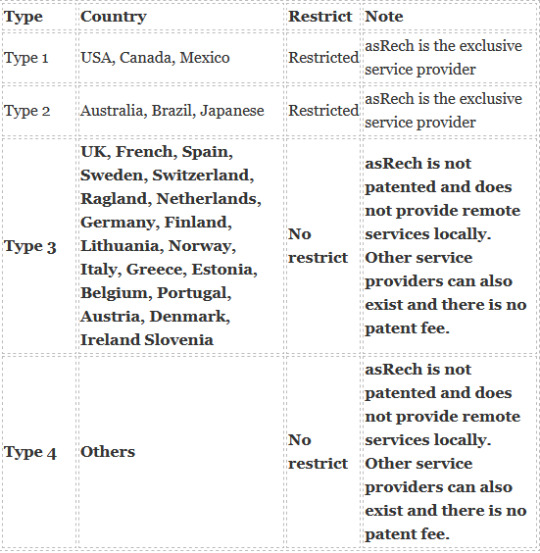
How does Launch SmartLink work?
It contains SmartLink C, SmartLink B and LAUNCH Super Remote Diagnosis Reservation Platform.
Smartlink C is for Auto repair factory, etc (as client end)
X431 SmartLink C is connected to vehicle via OBDII cable, and connected to LAUNCH Super Remote Diagnosis Reservation Platform via Internet, Launch J2534 Tool needs to be installed on PC and connected to Launch Reservation Platform as well.
Smartlink B is for remote engineer/technician (as business end)
It is connected to Launch X431 scan tool, OEM tool or other brand diagnostic tools via VCI/OBDII connection, and connected to Launch Reservation Platform via Internet.

How to Activate Launch SmartLink Remote Diagnosis function?
For X431 SmartLink C:
Method 1:Buy Launch Annual Activation Card (1 Year)
In this way, the function will be valid within 1 year.
After the subscription expires, renew it or buy renewal card (smartlink connections)
Method 2: Renewal Card (Smartlink Connections)
Active renewal card (free 3 connections included and they are invalid within 1 year)
After activation, users could buy 1/ 10/ 20/ 50 connections.
After connections run out, buy connections or buy renewal card (1 Year)
2.For SmartLink B
In this way, the function will be valid within 1 year.
After the subscription expires, renew it. (Smartlink B annual renew card)
Operation guide:
For Launch SmartLink C Activation
Main steps:
Register->Login->Issue remote diagnostic request-> Wait for acceptance from technician
1.Log in http://smartlink.x431.com/

2.Select user type (Common user)

3.Fill in the registration information incl. username, E-mail, verification code, and password.

4.The binding and activation of the C-side, the serial number and activation code of the C-side are entered here.


5.Enter the card number and password of the Smartlink C activation card.

6.Enter vehicle information, contact information, etc. to submit an appointment.

7.When choosing service technician, try to choose a service provider that you are familiar with.

8.Wait for the service provider to contact you to negotiate the processing time, etc.

For X431 SmartLink B Activation
Main steps:
Register->Log in->Accept remote diagnostic request
1.Visit http://smartlink.x431.com to register
2.Select user type (Service provider)
3.Input your email address, verification code (received from email), password, product Serial Number and Activation code (pasted as “S/N” and “A/C” on the rear side of Smartlink C device)

4.After registration, you can log in to the platform below

If you have more Smartlink devices, you can click “Add a device” on this page, and then input product serial number and activation code:

5.You can check the request details and accept one that you can fix.

Remote Diagnosis Mode Instruction:
SmartlinkB_xxxxxx: it means you will use Smartlink B to take remote the client vehicle.
J2534 Remote diagnosis: it means you have installed OEM software and Launch Tech J2534 driver on your PC. You will take remote by J2534 protocol.
6.After you accept a request, you will get client contact information. You have to contact the client and guide them to fix the issue.

7.If you fix the vehicle issue, please click “Completed”. Or you may click “Give up” if you can’t solve it.
8.You can check diagnostic history by click “History task” on the main page.

Launch SmartLink B/C Super Remote Diagnostics Module(Vehicle Data Link Connector):
Launch Annual Activation Card for X431 SmartLink B & C Remote Diagnosis:
Launch SmartLink C Super Remote Diagnostics Function Activation Card with 3 Times (For Times Cards Users):
Launch 1 Time Activation Card for SmartLink C Remote Diagnosis Renewal Card:
Launch 10 Times Activation Card for SmartLink C Remote Diagnosis Renewal Card:
Launch 20 Times Activation Card for X431 SmartLink C Remote Diagnosis Renewal:
Launch 50 Times Activation Card for X431 SmartLink C Remote Diagnosis Renewal:
FYI...
Launch X431 SmartLink C Super Remote Diagnosis Module VS SmartLink C Heavy Duty Truck Module:
Launch X431 PRO5, PAD5, and PAD7 come with SmartLink C V2.0 super remote diagnosis module (Item No.SP558), you can activate the remote diagnosis function for commercial vehicles by the above method, no need to buy an extra SmartLink C VCI.
Launch X431 SmartLink C 2.0 Heavy Duty Truck Module (Item No. SH104) is for Heavy-duty trucks, the remote diagnosis function is supported but needs to be activated, the function will open in the future.
If you don’t confirm if your Launch X431 SmartLink VCI can be activated, please feel free to contact our customer service.
Email: [email protected]
WhatsApp: +86 159 7293 3706
Skype: Eobdtool.co.uk
Business Time: Monday - Friday, 8:30am - 6:00pm CST (UTC/ GMT+08:00)
0 notes
Text
Perkins 2806F Engine Inlet Module (Catalyst) Remove and Install Guide
This article mainly introduces Perkins 2806F Engine Inlet Module (Catalyst) Remove and Install
Perkins EST Diagnostic Adapter- High Quality WARNING: Hot engine components can cause injury from burns. Before performing maintenance on the en-gine, allow the engine and the components to cool. WARNING: Wear goggles, gloves, protective clothing, and a National Institute for Occupational Safety and Health (NIOSH) approved P95 or N95 half-face respirator when handling a used Diesel Particu- late Filter or Catalytic Converter Muffler. Failure to do so could result in personal injury. 1. To remove the inlet module (Catalyst), access to the underside of the clean emission module will be required. Refer to the Original Equipment Manufacturer (OEM) for the correct location and the correct procedure to gain access to the underside of the inlet module (Catalyst). 2. Remove temperature sensor (7). Refer to Disassembly and Assembly, Temperature Sensor (DPF Inlet, Flame Detect) - Remove and Install for the correct procedure. 3. Loosen hose clamp (5) for tube assembly (6). Disconnect tube nut (3) for the tube assembly. Remove the tube assembly from inlet module catalyst (4). 4. Sufficiently loosen clamp (1) and clamp (2) to allow removal of inlet module catalyst (4). 5. Sufficiently loosen band clamp (8) to allow removal of inlet module catalyst (4). 6. Remove inlet module catalyst (4) Perkins SPI2 Version 2018A Service & Parts Catalogue Software Installation Procedure 1. When installing a new inlet module catalyst, a “ Diesel Oxidation Catalyst (DOC) Reset” must be performed. Refer to Troubleshooting, Service Tool Features or your Perkins distributor for more information. Viewed from the inlet module catalyst assembly. 2. Install a new clamp (1). Position the clamp to Dimension (Y) of 30° ± 5°. Refer to Illustration 183 3. Install a new clamp (8). Ensure that the clamp is correctly orientated. 4. Install inlet module catalyst (4). Ensure that the clamp (8) and clamp (1) are correctly seated on to the inlet module catalyst. Hand tighten the clamps. 5.Apply Tooling (A) to the threads of clamp (2) along Distance (Z). Distance (Z) is 25 mm ( 1.0 inch) above the trunnion. 6. Tighten band clamp (1) to a torque of 60 N·m (44 lbft). Ensure that the band clamp remains in the correct position. Refer to Illustration 184 for the correct position. Note: Do not use power tools to torque the clamp. 7. Tighten band clamp (2) to a torque of 15 N·m ( 133 lb in). Note: Do not use power tools to torque the clamp. 2023A& 2022A Perkins EST Electronic Service Tool Diagnostic Software Full Provide Installation Service Cutaway view of band clamp (8) in position on the assembly. 8. Torque band clamp (6) to a torque of 35 ± 2 N·m (26 ± 1 lbft). Verify that the cup of the Ball Joint (G) does not touch the radius of the Ball (F). Position band clamp (8) and hand tighten the band clamp. The band clamp should be in the center of the joint. Dimension (D) and Dimension (E) should be equal within 2.0 mm (0.08 inch). Repeat the measurements every 90° around band clamp (8). If necessary, adjust the band clamp. Tighten tube nut (3) to a torque of 40 N·m (30 lbft) . Ensure that tube assembly (6) is not strained as the tube nut is tightened. 9. Install temperature sensor (7). Refer to Disassembly and Assembly, Temperature Sensor (DPF Inlet, Flame Detect) - Remove and Install for the correct procedure. 10. Connect tube assembly (6) to the elbow adapter on inlet module catalyst (4) and to the hose assembly. 11. Hand tighten tube nut (3) for tube assembly (6). 12. Tighten hose clamp (5) to a torque of 1.4 N·m ( 12 lb in).
0 notes